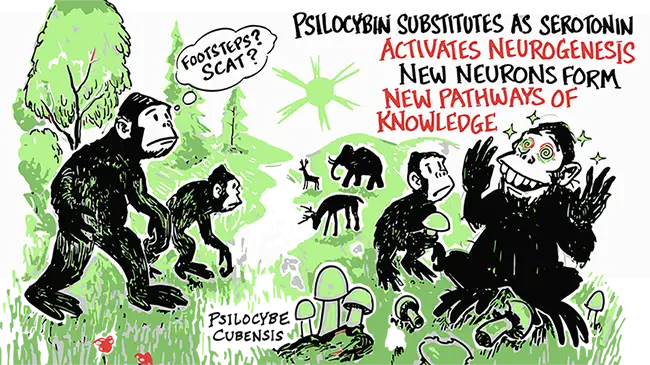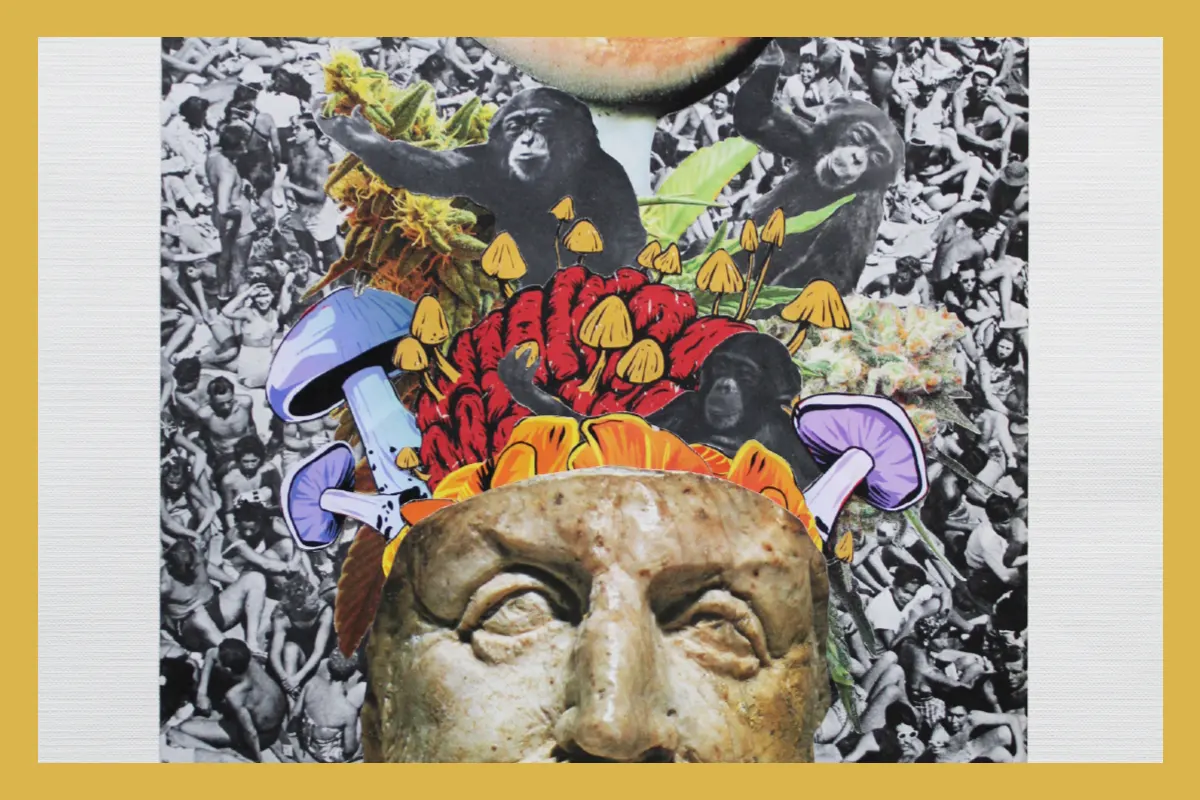How has the human species gotten to where it is today? How did we evolve from our ape-like ancestors to the thinking, governing, creative societies we now are? Some researchers subscribe to an unexpected theory: humanity has reached its bipedal heights through an organism that grows in the ground—psychedelic mushrooms. This is known as the Stoned Ape Theory.
The Stoned Ape Theory, first proposed by ethnobotanist Terence McKenna, states that our ancestor species Homo erectus evolved into the current iteration of humans, Homo sapiens, due to the consumption of Psilocybe cubensis mushrooms. Allegedly, these mushrooms caused early humans to develop larger brains and greater intellectual capacity—most meaningfully, the capacity for self-awareness.
What is The Stoned Ape Theory?
“The hypothesis suggests that the evolution of human consciousness was triggered by the consumption of psilocybin mushrooms by early hominids, which led to increased brain activity and improved cognitive abilities,” says Ryan Sultan, a mental health physician, clinical director of Integrative Psych, and research professor at Columbia University. “The consumption of these mushrooms was facilitated by the hominids’ habit of scavenging for food in the dung of large herbivores.”
According to the Stoned Ape Theory, mushrooms profoundly shaped what it means to be human. “McKenna argued that the effects of psilocybin, which alters perception and enhances creativity, contributed to the development of language, art, and religion,” says Taha Arooj, assistant professor of botany at Government College University in Pakistan and horticultural expert for Chase Horticultural. “McKenna believed that the use of psychedelics allowed early humans to break out of their instinctual behaviors and develop more complex social structures. He argued that these experiences could have led to the development of mythologies, rituals, and a sense of spirituality.”
But how could such a fascinatingly complex phenomenon occur, and how plausible is it? Read on to learn about the Stoned Ape Theory, what it means for us, and how much evidence is actually behind it.
READ: Yes, Psychedelics Do Change Our Metaphysical Beliefs
Evidence for the Stoned Ape Theory
The name “Stoned Ape Theory” is a bit of a misnomer, Sultan says. It’s really a hypothesis. There is not enough evidence to form a scientific theory, which is a coherent explanation based on solid facts. However, there is some evidence to support the hypothesis.
How to Grow Shrooms Bundle
Take Both of Our Courses and Save $90!
One fact that McKenna and other proponents of the Stoned Ape Theory draw upon is that magic mushrooms have long been used in ceremonial rituals in many cultures throughout human history. This suggests “that they may have been considered sacred or otherwise valuable to human societies,” says Sultan.
“The earliest definitive evidence of human use of psychoactive substances comes from archaeological sites that are thousands of years old, although it’s likely that such usage extends much further back in prehistory,” he explains. “Many psychoactive substances come from plants that have been part of the ecosystems where humans evolved, so it’s quite likely that the use of such substances extends back to the earliest chapters of human history.”

James Giordano, professor of neurology and biochemistry at Georgetown University Medical Center, agrees that early humans most likely came into contact with mushrooms, since they’re some of the oldest and most common psychedelics to exist. And, crucially, there is archeological evidence that during the time in our evolution when our brain size drastically increased, human settlements existed in places where mushrooms grew, according to Sultan.
The other piece of evidence that the Stoned Ape Theory relies on is that mushrooms allow for “improved problem-solving abilities, enhanced visual acuity, and other cognitive benefits,” which would have been favored by natural selection and carried on to the next generation, says Sultan.
But How Is That Actually Possible?
This all begs the question: how could early hominids’ consumption of mushrooms have affected future generations? Clearly, psychedelics affect the minds and behavior of people who take them—but would they really influence the biological makeup of those people’s children?
If our ancestors’ mushroom consumption were to affect their progeny, this would likely occur by means of the epigenome—the chemical compounds that influence how genes build proteins and cells in the body. While consuming mushrooms would likely not affect you or your offspring’s genes, there is some evidence that psychedelics could affect how genes are expressed, particularly in the brain.
“Psilocybin has been shown to increase neuroplasticity, or the ability of the brain to reorganize and form new neural connections,” says Sultan. “This could potentially lead to epigenetic changes by altering gene expression related to neural growth and development.” Psilocybin could also potentially affect the epigenome through its modulation of stress hormones and mood regulation, its effects on the receptors for the neurotransmitter serotonin, and its anti-inflammatory properties, he adds.

Still, these are just possible mechanisms; we do not know if any of this has actually happened. And even if the effects of mushrooms on the brain could be passed down from one generation to another, there’s still a problem with the theory, says Giordano: For it to make sense, mushroom usage would have had to be so prevalent, it affected the entire human species. “The idea that enough humans did this in such a widespread way that consuming psychedelics was contributory to a mass shift in human cognition is pretty unlikely,” he says.
Arooj adds that “there are alternative explanations for the emergence of human culture and consciousness, such as increased brain size, tool-making abilities, and social cooperation.” All in all, she says, the Stoned Ape Theory is not generally accepted in the scientific community due to the insufficient evidence.
READ: Ego Death: Everything You Should Know
What Actually Happened, Then?
What’s likelier is that a cultural process of evolution, rather than a biological one, took place due to humans’ early use of mushrooms, says Giordano. “There are aspects of human neurocognition that are, in fact, enhanceable through a variety of different things, and humans sort of figured it out through trial and error, and that became codified through sociocultural practice,” he explains. “There’s certainly a social shaping that went along with it, and there are practices that became profound for healing in different ways, such as spiritual healing and shamanic healing.”
In other words, mushrooms could have influenced the development of things like art and religion, not because humans who took mushrooms had children with a biological propensity toward those things, but because their children (and their children’s children, and so on) took mushrooms themselves. Not only that, but the shamanic rituals around mushrooms were also likely passed down, further shaping human spirituality and society. And because humans have consumed psychedelics in groups, ideas people formed on mushrooms had the chance to spread.

This evolutionary process is arguably still happening; Giordano points to 1960s music as evidence that psychedelics continue to shape our culture. Today, you can see the evidence of psychedelics’ impact on culture through the rise of shamanism throughout the world. People whose ancestors may have been raised Christian, for instance, are now being exposed to alternative spiritualities through ayahuasca and mushroom ceremonies.
“That doesn’t dispel the Stoned Ape Theory; it just sort of modifies it,” says Giordano. “It says, here’s this thinking ape, an ape that walks upright, a hominid primate that at some point, perhaps accidentally, stumbled upon this substance that interacts with their biology and said, ‘Wow, that was a trip, literally! Let’s do it again.’ They all did this together, and they ritualized the actual practices of the seeking of the thing, the obtaining of the thing, the preparation of the thing, and the actual doing of the thing. There’s a particular shaping that goes along with that; these are exceptional experiences.”
So, while the notion that mushrooms literally changed the structure of the human brain and body may not have solid evidence behind it, the idea that mushrooms have shaped human cultures for thousands of years likely does. If there’s anything that the role of mushrooms in influencing people’s evolution throughout the world tells us, it simply adds to the current evidence that mushrooms can “promote creativity, problem-solving, and spiritual growth,” Sultan says.

DoubleBlind is a trusted resource for news, evidence-based education, and reporting on psychedelics. We work with leading medical professionals, scientific researchers, journalists, mycologists, indigenous stewards, and cultural pioneers. Read about our editorial policy and fact-checking process here.

DoubleBlind Magazine does not encourage or condone any illegal activities, including but not limited to the use of illegal substances. We do not provide mental health, clinical, or medical services. We are not a substitute for medical, psychological, or psychiatric diagnosis, treatment, or advice. If you are in a crisis or if you or any other person may be in danger or experiencing a mental health emergency, immediately call 911 or your local emergency resources. If you are considering suicide, please call 988 to connect with the National Suicide Prevention Lifeline.



